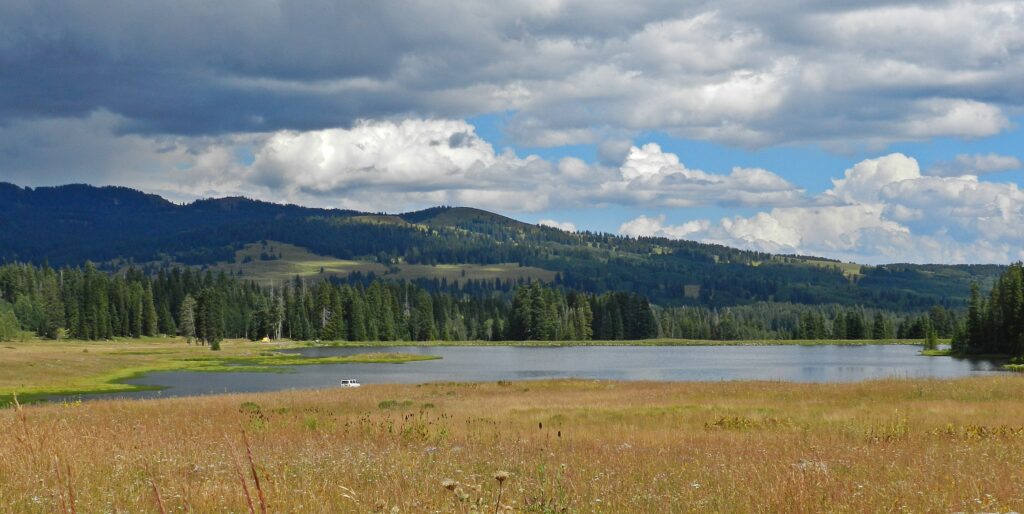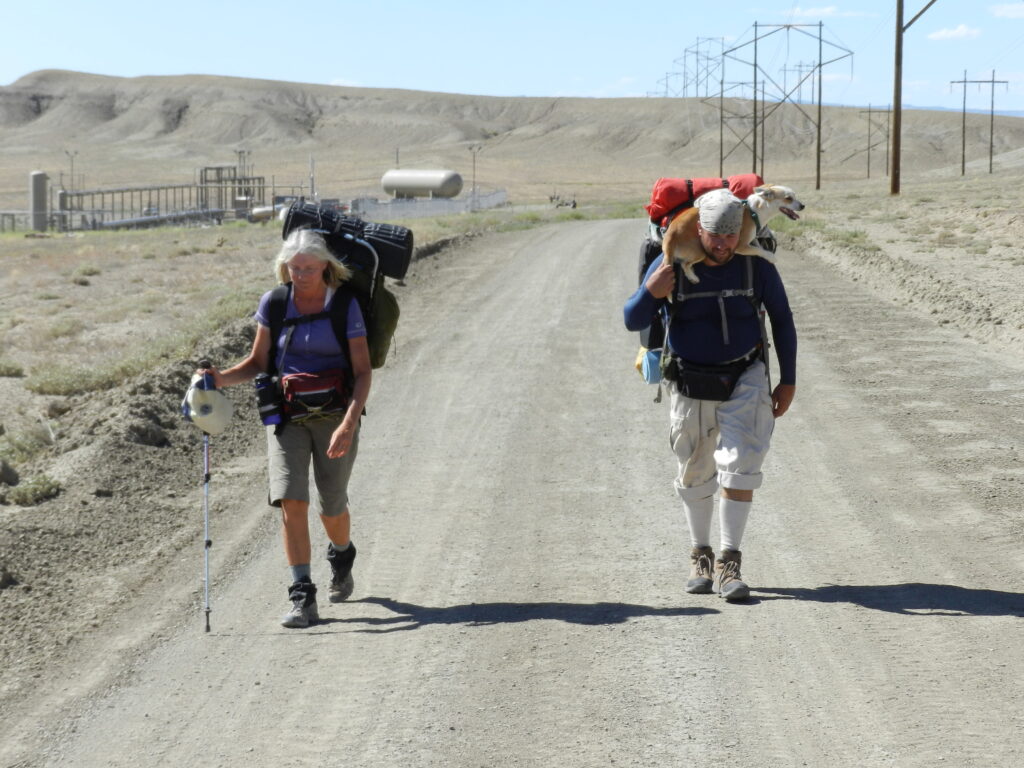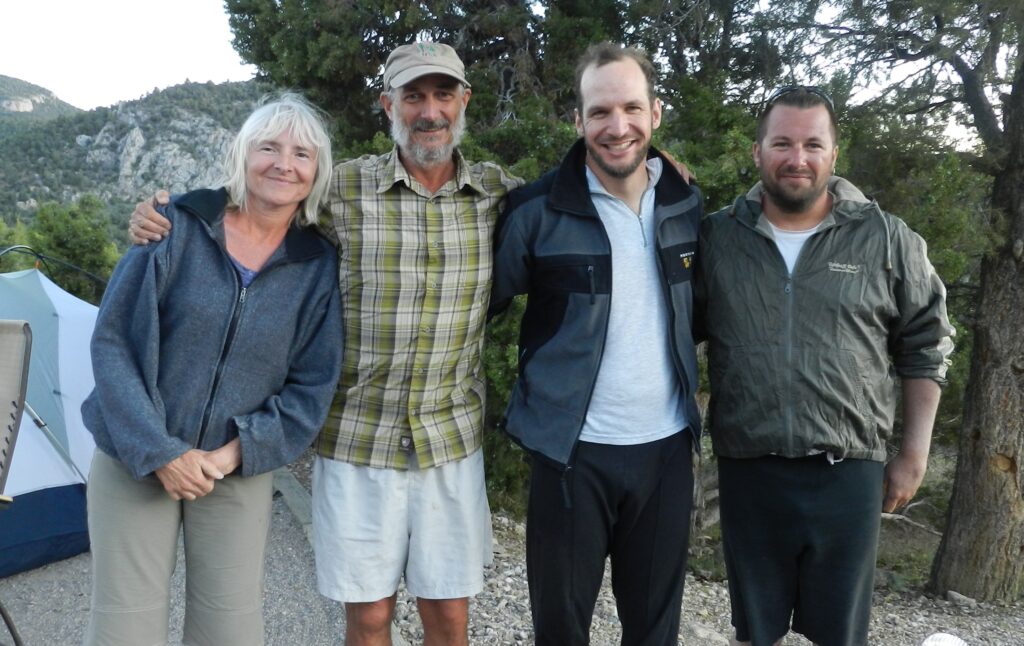Two days out of Leadville found us hanging around the Copper Mountain resort area, where we took a break at the Daylight Donuts establishment, chowing down donuts and pastries, some free of charge. In truth we were procrastinating, as the cold, overcast weather that afternoon boded ill tidings for our return to mountain ridges. Our procrastination led to a serendipitous chain of events, which lasted until Illinois.
As we lingered around eating donuts and pastries several interested people talked to us, including a Nebraskan couple touring on motorcycles, who gave us twenty dollars. The serendipity began when we met Andy Held. He informed us that a significant amount of snow was forecast for the higher elevations that evening and suggested the alternative of hiking on a bike path to Frisco, where he would put us up in a hotel for the night. He also would take us out for breakfast the next morning for a longer chat.
Hmmmm. We had a choice between taking the high route through mountain snowstorms, or the low route to a hotel, free breakfast and who knows what else. We chose the low route, gladly adding six more miles to our day and not arriving in Frisco until dark. The extra mileage aggravated my left foot, which otherwise had been feeling better since we left Utah, but this alternative promised to be worth the extra pain.
At breakfast the next morning Andy shared some of Frisco’s community oriented activities. He also put in a good word to MountainSmith for us, for Cindy was in need of a new pack and they contracted with Andy as a web marketer. In addition to our good fortune from meeting Andy, our presence in Frisco led to both a short and long term serendipitous chain.
We arranged to meet Ky at the Frisco Visitor Center to resupply for our next stretch up and over Argentine Pass, highest point on the American Discovery Trail and our final crossing to the east side of the Continental Divide. The long term serendipitous chain began when we met three tourists from Kansas City at the visitor center while waiting for Ky. They took a great interest in our journey and we took a great interest in possibly having a place to stay when the ADT brought us through Kansas City.
Before we parted, Ardie and Gretchen acquired our email address for later contact and gave to us another twenty dollar bill, for the third time in less than a week and the seventh time overall. I want to make clear we never asked for donations during the journey; people just kept giving to us even when we tried to refuse. In any case, twenty dollars pales in value to what Ardie and Gretchen would do for us later in the journey.
The Summit Daily newspaper in Frisco, which lies in the appropriately named Summit County, interviewed us while we were in town. That began the short chain of serendipitous events over the next few days, as we hiked through the towns of the broad valley nestled between majestic peaks. Our next town after Frisco was Dillon, which we did not reach until dark due to a series of delays and miscalculations.
We hoped to camp in the National Forest that evening, but the full campground forced us to move on. After the National Forest came the Dillon Reservoir, with no camping allowed. That explained our late arrival into a populated area with no obvious prospects for camping, given our limited financial means.
We approached a police officer parked at a municipal park and asked if we could stay in the park for the night, explaining that we were walking 5,000 miles across the country. He said no, he would give us a ticket. We then asked if we could spend the night in jail, a tactic used by some of my long distance hiker friends in the past. He reiterated that he would give us a ticket if we continued to linger and added that the police in Dillon do not have a sense of humor.
We saw no other alternative but to bust the budget and rent a room in a Best Western that night. The next morning we went to the lobby for the continental breakfast. In the paper rack was the Summit Daily with a picture of us prominently featured. The manager at the desk took note of the resemblance between the photo and us and comped us the room, resolving our budget dilemma. I only hoped that the police officer we met saw us in that paper as well.
The next town after Dillon was Keystone. As we hiked along the bike path from end to end through the town we encountered a few other people who noted the similarity between us and the Summit Daily photo. A bridal party adopted us and treated us at a coffee shop near the route. We took our time with the hope that the stormy weather that day would pass. When we reached the far end of Keystone, huddling under a bus stop in a steady rain, we were rescued from going further that day by Deb Stein, another Summit Daily reader who paid for another hotel stay that night.
During a four day stretch of mostly bad weather in the mountains we spent three nights in three different hotels, all free of cost, all comped by different people, thanks to a chance encounter with Andy Held. Fortunately, the last day of bad weather was more rain than snow in the mountains, mostly clearing the trails for our momentous ascent over Argentine Pass. A sparkling clear day greeted us as we finally left our hospitable valley behind.
Cindy once again struggled above 12,000’, but this would be our last climb of that magnitude. We took a break at the pass for a good while, parked against the lee side of some rocks to reduce the windy cold. Our climb had been where the typical rain shadow on the western side of major mountains nurtures abundant vegetation. The east side of Argentine Pass, all the more drier from the same rain shadow effect, appeared barren in contrast.

We watched another hiker ascend towards us, wearing a much lighter pack with plans to loop back down before the end of the day. Well behind his schedule, he left the pass before we did in order to get down before dark. He may not have succeeded.
By arriving at Argentine Pass on September 18 we accomplished our goal of getting over the Continental Divide before September 22. Just a short distance north, on the same date, a blizzard snowed in our group at 11,000’ in the Arapaho Wilderness. I originally hoped to cross the divide on September 19, for our 25th anniversary, but we arrived a day early to take advantage of the clear weather.
We officially celebrated our 25th in January with a vacation in Kauai, but spending this brief time together above 13,000’ seemed a more fitting way to toast our wonderful journey together. Cindy again showed signs of cognitive improvement since her stressed out lows in Utah, but that hopeful sign did not overcome a feeling of nostalgia that this break may be the last one for us to feel on top of the world together.
We ended our break and turned to go down the barren east side of the Continental Divide, a couple of long distance hikers doing their thing together.









